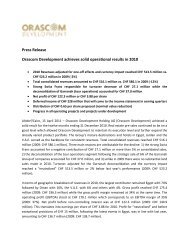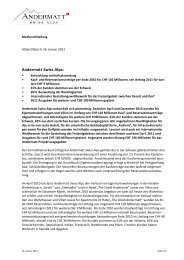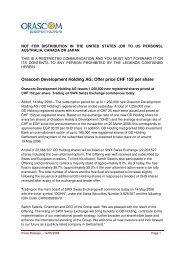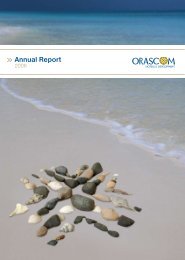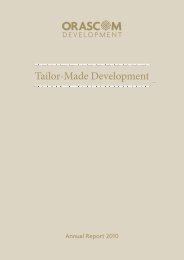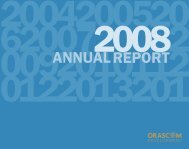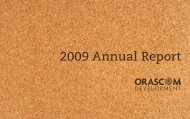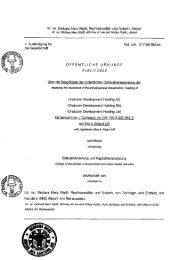FY 2010 Annual Report - Part II - Orascom Development
FY 2010 Annual Report - Part II - Orascom Development
FY 2010 Annual Report - Part II - Orascom Development
Create successful ePaper yourself
Turn your PDF publications into a flip-book with our unique Google optimized e-Paper software.
<strong>Orascom</strong> <strong>Development</strong> Holding (Consolidated Financial Statement)<br />
obtains control) and the resulting gain or loss, if any, is<br />
recognised in profit or loss. Amounts arising from interests in the<br />
acquiree prior to the acquisition date that have previously been<br />
recognised in other comprehensive income are reclassified to<br />
profit or loss where such treatment would be appropriate if that<br />
interest were disposed of.<br />
If the initial accounting for a business combination is incomplete<br />
by the end of the reporting period in which the combination<br />
occurs, the Group reports provisional amounts for the items for<br />
which the accounting is incomplete. Those provisional amounts<br />
are adjusted during the measurement period (see above), or<br />
additional assets or liabilities are recognised, to reflect new<br />
information obtained about facts and circumstances that existed<br />
at the acquisition date that, if known, would have affected the<br />
amounts recognised at that date.<br />
Business combinations that took place prior to 1 January <strong>2010</strong><br />
were accounted for in accordance with the previous version of<br />
IFRS 3.<br />
For common control transactions in which all of the combining<br />
entities or businesses ultimately are controlled by the same party<br />
or parties both before and after the combination, and that control<br />
is not transitory, the Group recognises the difference between<br />
purchase consideration and net assets of acquired entities or<br />
businesses as an adjustment to equity. This accounting treatment<br />
is also applied to later acquisitions of some or all shares of the<br />
non-controlling interests in a subsidiary.<br />
3.9 Investment in associates<br />
The Group applied the requirements of the new version of IAS 28<br />
(as amended in 2008) in accounting for its investments in<br />
associates starting from 1 January <strong>2010</strong> since it applied as well<br />
IAS 27 (as amended in 2008) from that date. The new policy is<br />
set out below.<br />
An associate is an entity over which the Group has significant<br />
influence and that is neither a subsidiary nor an interest in a joint<br />
venture. Significant influence is the power to participate in the<br />
financial and operating policy decisions of the investee but is not<br />
control or joint control over those policies.<br />
The results, assets and liabilities of associates are incorporated in<br />
these consolidated financial statements using the equity method<br />
of accounting, except when the investment is classified as held for<br />
sale, in which case it is accounted for in accordance with IFRS 5<br />
Non-current Assets Held for Sale and Discontinued Operations.<br />
Under the equity method, an investment in an associate is initially<br />
recognised in the consolidated statement of financial position at<br />
cost and adjusted thereafter to recognise the Group's share of the<br />
profit or loss and other comprehensive income of the associate.<br />
When the Group's share of losses of an associate exceeds the<br />
Group's interest in that associate (which includes any long-term<br />
interests that, in substance, form part of the Group's net<br />
investment in the associate), the Group discontinues recognising<br />
its share of further losses. Additional losses are recognised only to<br />
the extent that the Group has incurred legal or constructive<br />
obligations or made payments on behalf of the associate.<br />
Any excess of the cost of acquisition over the Group’s share of the<br />
net fair value of the identifiable assets, liabilities and contingent<br />
liabilities of an associate recognised at the date of acquisition is<br />
recognised as goodwill, which is included within the carrying<br />
amount of the investment. Any excess of the Group’s share of the<br />
net fair value of the identifiable assets, liabilities and contingent<br />
liabilities over the cost of acquisition, after reassessment, is<br />
recognised immediately in profit or loss.<br />
The requirements of IAS 39 are applied to determine whether it is<br />
necessary to recognise any impairment loss with respect to the<br />
Group’s investment in an associate. When necessary, the entire<br />
carrying amount of the investment (including goodwill) is tested<br />
for impairment in accordance with IAS 36 Impairment of Assets as<br />
a single asset by comparing its recoverable amount (higher of<br />
value in use and fair value less costs to sell) with its carrying<br />
amount. Any impairment loss recognised forms part of the<br />
carrying amount of the investment. Any reversal of that<br />
impairment loss is recognised in accordance with IAS 36 to the<br />
extent that the recoverable amount of the investment subsequently<br />
increases.<br />
When a Group entity transacts with associates of the Group,<br />
profits and losses resulting from the transactions with the<br />
associate are recognised in the Group’s consolidated financial<br />
statements only to the extent of interests in the associate that are<br />
not related to the Group.<br />
3.10 Goodwill<br />
Goodwill arising on an acquisition of a business is carried at cost<br />
as established at the date of acquisition of the business (see note<br />
3.8) less accumulated impairment losses, if any.<br />
For the purposes of impairment testing, goodwill acquired in a<br />
business combination is allocated, starting from the acquisition<br />
date, to each of the Group’s cash-generating units (or groups of<br />
cash-generating units) that is expected to benefit from the<br />
synergies of the combination. When assessing each unit or group<br />
of units to which the goodwill is so allocated, the Group’s<br />
objective is to test goodwill for impairment at a level that reflects<br />
the way the Group manages its operations and with which the<br />
goodwill would naturally be associated under the reporting system<br />
in place.<br />
A cash-generating unit to which goodwill has been allocated is<br />
tested for impairment annually, or more frequently when there is<br />
indication that the unit may be impaired. If the recoverable<br />
amount of the cash-generating unit is less than its carrying<br />
amount, the impairment loss is allocated first to reduce the<br />
carrying amount of any goodwill allocated to the unit and then to<br />
the other assets of the unit pro-rata based on the carrying amount<br />
of each asset in the unit. Any impairment loss for goodwill is<br />
recognised directly in the profit or loss in the consolidated<br />
statement of comprehensive income. An impairment loss<br />
recognised for goodwill is not reversed in subsequent periods.<br />
On disposal of the relevant cash-generating unit, the attributable<br />
amount of goodwill is included in the determination of the profit<br />
or loss on disposal.<br />
The Group’s policy for goodwill arising on the acquisition of an<br />
associate is described in note 3.9.<br />
F-15



